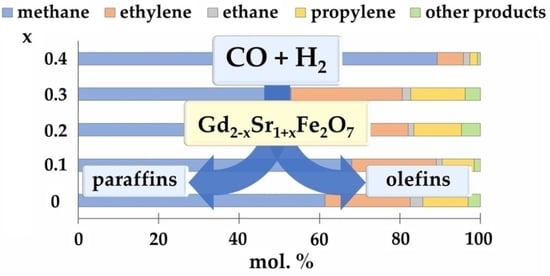Insights into the Reactivity of Gd2−xSrxFe2O7 (x = 0 ÷ 0.4) in CO Radical Hydrogenation
Abstract
:1. Introduction
- -
- Flexibility in terms of activity, selectivity, and reaction conditions;
- -
- High selectivity to olefins within the Anderson–Schulz–Flory hydrocarbon distribution;
- -
- Sensitivity of reaction rate and selectivity to promotion and support;
- -
- Activity in the water–gas shift (WGS) reaction and the possibility of using syngas with variable H2/CO ratios;
- -
- Presence of different phases that are potentially active in FT synthesis;
- -
- Relative stability in the presence of syngas impurities compared to cobalt catalysts;
- -
- Lower cost compared to other metal catalysts.
2. Results and Discussion
2.1. Characterization
2.2. Catalytic Tests
3. Materials and Methods
3.1. Catalyst Preparation
- -
- Gd2SrFe2O7 and Gd1.9Sr1.1Fe2O7—at 1523 K for 20 min;
- -
- Gd1.7Sr1.3Fe2O7 and Gd1.8Sr1.2Fe2O7—at 1523 K for 1 h;
- -
- Gd1.6Sr1.4Fe2O7—at 1523 K for 3 h.
3.2. Characterization
3.3. Catalytic Activity Tests
4. Conclusions
Author Contributions
Funding
Data Availability Statement
Acknowledgments
Conflicts of Interest
References
- Peña, M.A.; Fierro, J.L.G. Chemical Structures and Performance of Perovskite Oxides. Chem. Rev. 2001, 101, 1981–2018. [Google Scholar] [CrossRef] [PubMed]
- Royer, S.; Duprez, D.; Can, F.; Courtois, X.; Batiot-Dupeyrat, C.; Laassiri, S.; Alamdari, H. Perovskites as Substitutes of Noble Metals for Heterogeneous Catalysis: Dream or Reality. Chem. Rev. 2014, 114, 10292–10368. [Google Scholar] [CrossRef] [PubMed]
- Giordano, L.; Akkiraju, K.; Jacobs, R.; Vivona, V.; Morgan, D.; Shao-Horn, Y. Electronic structure-based descriptors for oxide properties and functions. Acc. Chem. Res. 2022, 55, 298–308. [Google Scholar] [CrossRef] [PubMed]
- Hwang, J.; Rao, R.R.; Giordano, L.; Katayama, Y.; Yu, Y.; Shao-Horn, Y. Perovskites in catalysis and electrocatalysis. Science 2017, 358, 751–756. [Google Scholar] [CrossRef]
- Xu, X.; Zhong, Y.; Shao, Z. Double Perovskites in Catalysis, Electrocatalysis, and Photo(electro)catalysis. Trends Chem. 2019, 1, 410–424. [Google Scholar] [CrossRef]
- Zhao, K.; He, F.; Huang, Z.; Wei, G.; Zheng, A.; Li, H.; Zhao, Z. Perovskite-type oxides LaFe1−xCoxO3 for chemical looping steam methane reforming to syngas and hydrogen co-production. Appl. Energy 2016, 168, 193–203. [Google Scholar] [CrossRef]
- Salker, A.V.; Gurav, S.M. Electronic and catalytic studies on Co1−xCuxMn2O4 for CO oxidation. J. Mater. Sci. 2000, 35, 4713–4719. [Google Scholar] [CrossRef]
- de Caprariis, B.; de Filippisa, P.; Palma, V.; Petrullo, A.; Ricca, A.; Ruocco, C.; Scarsella, M. Rh, Ru and Pt ternary perovskites type oxides BaZr(1−x)MexO3 for methane dry reforming. Appl. Catal. A Gen. 2016, 517, 47–55. [Google Scholar] [CrossRef]
- Amin, A.S.; Yaw, T.C. Thermodynamic equilibrium analysis of combined carbon dioxide reforming with partial oxidation of methane to syngas. Int. J. Hydrogen Energy 2007, 32, 1789–1798. [Google Scholar] [CrossRef]
- Song, X.; Dong, X.; Yin, S.; Wang, M.; Li, M.; Wang, H. Effects of Fe partial substitution of La2NiO4/LaNiO3 catalyst precursors prepared by wet impregnation method for the dry reforming of methane. Appl. Catal. A Gen. 2016, 526, 132–138. [Google Scholar] [CrossRef]
- Aksenova, T.V.; Mysik, D.K.; Cherepanov, V.A. Crystal Structure and Properties of Gd1−xSrxCo1−yFeyO3−δ Oxides as Promising Materials for Catalytic and SOFC Application. Catalysts 2022, 12, 1344. [Google Scholar] [CrossRef]
- Yang, E.; Noh, Y.; Ramesh, S.; Lim, S.S.; Moon, D.J. The effect of promoters in La0.9M0.1Ni0.5Fe0.5O3 (M = Sr, Ca) perovskite catalysts on dry reforming of methane. Fuel Process. Technol. 2015, 134, 404–413. [Google Scholar] [CrossRef]
- Zhang, Z.; Ou, Z.; Qin, C.; Ran, J.; Wu, C. Roles of alkali/alkaline earth metals in steam reforming of biomass tar for hydrogen production over perovskite supported Ni catalysts. Fuel 2019, 257, 116032. [Google Scholar] [CrossRef]
- Wei, T.; Jia, L.; Luo, J.; Chi, B.; Pu, J.; Li, J. CO2 dry reforming of CH4 with Sr and Ni co-doped LaCrO3 perovskite catalysts. Appl. Surf. Sci. 2020, 506, 144699. [Google Scholar] [CrossRef]
- Ao, M.; Pham, G.H.; Sage, V.; Pareek, V. Structure and activity of strontium substituted LaCoO3 perovskite catalysts for syngas conversion. J. Mol. Catal. A Chem. 2016, 416, 96–104. [Google Scholar] [CrossRef]
- Escalona, N.; Fuentealba, S.; Pecchi, G. Fischer–Tropsch synthesis over LaFe1−xCoxO3 perovskites from a simulated biosyngas feed. Appl. Catal. A Gen. 2010, 381, 253–260. [Google Scholar] [CrossRef]
- Morales, M.; Segarra, M. Steam reforming and oxidative steam reforming of ethanol over La0.6Sr0.4CoO3− δ perovskite as catalyst precursor for hydrogen production. Appl. Catal. A Gen. 2015, 502, 305–311. [Google Scholar] [CrossRef]
- Gholami, Z.; Gholami, F.; Tišler, Z.; Hubáček, J.; Tomas, M.; Bǎciak, M.; Vakili, M. Production of Light Olefins via Fischer-Tropsch Process Using Iron-Based Catalysts: A Review. Catalysts 2022, 12, 174. [Google Scholar] [CrossRef]
- Lin, Q.; Cheng, M.; Zhang, K.; Li, W.; Wu, P.; Chang, H.; Lv, Y.; Men, Z. Development of an Iron-Based Fischer–Tropsch Catalyst with High Attrition Resistance and Stability for Industrial Application. Catalysts 2021, 11, 908. [Google Scholar] [CrossRef]
- Chang, H.; Lin, Q.; Cheng, M.; Zhang, K.; Feng, B.; Chai, J.; Lv, Y.; Men, Z. Effects of Potassium Loading over Iron–Silica Interaction, Phase Evolution and Catalytic Behavior of Precipitated Iron-Based Catalysts for Fischer-Tropsch Synthesis. Catalysts 2022, 12, 916. [Google Scholar] [CrossRef]
- Zheng, Y.; Xu, C.; Zhang, X.; Wu, Q.; Liu, J. Synergistic Effect of Alkali Na and K Promoter on Fe-Co-Cu-Al Catalysts for CO2 Hydrogenation to Light Hydrocarbons. Catalysts 2021, 11, 735. [Google Scholar] [CrossRef]
- Gong, N.; Wu, Y.; Ma, Q.; Tan, Y. A Simple Strategy Stabilizing for a CuFe/SiO2 Catalyst and Boosting Higher Alcohols’ Synthesis from Syngas. Catalysts 2023, 13, 237. [Google Scholar] [CrossRef]
- Pan, Y.; Ding, X.; Zhang, C.; Zhu, M.; Yang, Z.; Han, Y.-F. Effects of Different Reductive Agents on Zn-Promoted Iron Oxide Phases in the CO2–Fischer–Tropsch to Linear-Olefins. Catalysts 2023, 13, 594. [Google Scholar] [CrossRef]
- Fatih, Y.; Burgun, U.; Sarioglan, A.; Atakül, H. Effect of sodium incorporation into Fe-Zn catalyst for Fischer- Tropsch synthesis to light olefins. Mol. Catal. 2023, 535, 112866. [Google Scholar] [CrossRef]
- Mierczy’nski, P.; Dawid, B.; Mierczynska-Vasilev, A.; Maniukiewicz, W.; Witońska, I.; Vasilev, K.; Szynkowska-Jóźwik, M.I. Novel bimetallic 1%M-Fe/Al2O3-Cr2O3 (2:1) (M = Ru, Au, Pt, Pd) catalysts for Fischer-Tropsch synthesis. Catal. Commun. 2022, 172, 106559. [Google Scholar] [CrossRef]
- Wang, C.; Zhu, H.; Zhang, L.; Huang, Z.; Chen, J. Tuning Fischer-Tropsch synthesis product distribution toward light olefins over nitrided Fe-Mn bimetallic catalysts. Fuel 2023, 343, 127977. [Google Scholar] [CrossRef]
- Hu, R.; Wang, T.; Wang, Y.; Zhu, Y.; Xie, L.; Xing, E.; Wu, Y.; Da, Z. Nano-Hollow Zeolite-Encapsulated Highly Dispersed Ultra-Fine Fe Nanoparticles as Fischer–Tropsch Catalyst for Syngas-to-Olefins. Catalysts 2023, 13, 948. [Google Scholar] [CrossRef]
- Pawelec, B.; Guil-López, R.; Mota, N.; Fierro, J.L.G.; Navarro Yerga, R.M. Catalysts for the Conversion of CO2 to Low Molecular Weight Olefins—A Review. Materials 2021, 14, 6952. [Google Scholar] [CrossRef]
- Li, Y.; He, Y.; Fujihara, K.; Wang, C.; Sun, X.; Gao, W.; Guo, X.; Yasuda, S.; Yang, G.; Tsubaki, N. A Core-Shell Structured Na/Fe@Co Bimetallic Catalyst for Light-Hydrocarbon Synthesis from CO2 Hydrogenation. Catalysts 2023, 13, 1090. [Google Scholar] [CrossRef]
- Chernyak, S.A.; Corda, M.; Dath, J.-P.; Ordomsky, V.V.; Khodakov, A.Y. Light olefin synthesis from a diversity of renewable and fossil feedstocks: State-of the-art and outlook. Chem. Soc. Rev. 2022, 51, 7994–8044. [Google Scholar] [CrossRef]
- Sheshko, T.F.; Markova, E.B.; Sharaeva, A.A.; Kryuchkova, T.A.; Zvereva, I.A.; Chislova, I.V.; Yafarova, L.V. Carbon Monoxide Hydrogenation over Gd(Fe/Mn)O3 Perovskite-Type Catalysts. Pet. Chem. 2019, 59, 1307–1313. [Google Scholar] [CrossRef]
- Yafarova, L.V.; Chislova, I.V.; Zvereva, I.A.; Kryuchkova, T.A.; Kost, V.V.; Sheshko, T.F. Sol–gel synthesis and investigation of catalysts on the basis of perovskite-type oxides GdMO3 (M = Fe, Co). J. Sol-Gel Sci. Technol. 2019, 92, 264–272. [Google Scholar] [CrossRef]
- Sheshko, T.F.; Kryuchkova, T.A.; Serov, Y.M.; Chislova, I.V.; Zvereva, I.A. New Mixed Perovskite-Type Gd2−xSr1+xFe2O7 Catalysts for Dry Reforming of Methane, and Light Olefins Production. Catal. Ind. 2017, 9, 162–167. [Google Scholar] [CrossRef]
- Sheshko, T.F.; Serov, Y.M.; Kryuchkova, T.A.; Khairullina, I.A.; Chislova, I.V.; Zvereva, I.A. Interaction between carbon oxides, hydrogen and Fe2O3 and An+1FenO3n +1 (A = Gd, Sr, n = 1, 2, …, ∞). Russ. J. Phys. Chem. 2016, 90, 1137–1142. [Google Scholar] [CrossRef]
- Ivanov, D.V.; Sadovskaya, E.M.; Pinaeva, L.G.; Isupova, L.A. Influence of Oxygen Mobility on Catalytic Activity of La-Sr-Mn-O Composites in the Reaction of High Temperature N2O Decomposition. J. Catal. 2009, 267, 5–13. [Google Scholar] [CrossRef]
- Sugunan, S.; Meera, V. Acid-base properties and catalytic activity of ABO3 (perovskite-type) oxides consisting of rare earth and 3d transition metals. React. Kinet. Catal. 1997, 62, 327–332. Available online: https://link.springer.com/article/10.1007/BF02475471 (accessed on 1 July 2023). [CrossRef]
- Polo-Garzon, F.; Wu, Z. Acid–base catalysis over perovskites: A review. J. Mater. Chem. A 2018, 6, 2877–2894. Available online: https://pubs.rsc.org/en/content/articlelanding/2018/ta/c7ta10591f (accessed on 1 July 2023). [CrossRef]
- Sharma, I.B.; Singh, D.; Magotra, S.K. Effect of substitution of magnetic rare earths for La on the structure, electric transport and magnetic properties of La2SrFe2O7. J. Alloys Compd. 1998, 269, 13–16. [Google Scholar] [CrossRef]
- Shilova, A.; Chislova, I.; Panchuk, V.; Semenov, V.; Zvereva, I. Evolution of iron electronic state in the solid solutions Gd2−xSr1+xFe2O7−δ. Solid State Phenom. 2013, 194, 116–119. [Google Scholar] [CrossRef]
- Sheshko, T.F.; Serov, Y.M.; Dement’eva, M.V.; Shul’ga, A.; Chislova, I.V.; Zvereva, I.A. Catalytic Hydrogenation of Carbon Monoxide over Nanostructured Perovskite-Like Gadolinium and Strontium Ferrites. Russ. J. Phys. Chem. A 2016, 90, 926–931. [Google Scholar] [CrossRef]
- Pylinina, A.I.; Povarova, E.I.; Mikhalenko, I.I.; Yagodovskaya, T.V. Effect of plasma-chemical and thermal treatment in oxygen on the activity of Na3ZrM(PO4)3 phosphates (M = Zn, Co, Cu) in the transformation of butanol-2. Russ. J. Phys. Chem. 2013, 87, 929–934. [Google Scholar] [CrossRef]
- Liu, B.; Li, W.; Zheng, J.; Lin, Q.; Zhang, X.; Zhang, J.; Jiang, F.; Xu, Y.; Liu, X. CO2 formation mechanism in Fischer–Tropsch synthesis over iron-based catalysts: A combined experimental and theoretical study. Catal. Sci. Technol. 2018, 8, 5288. [Google Scholar] [CrossRef]
- Ma, Z.; Wang, X.; Ma, X.; Tan, M.; Yang, G.; Tan, Y. Catalytic roles of acid property in different morphologies of HZSM-5 zeolites for syngas-to-aromatics conversion over ZnCrOx/H-ZSM-5 catalysts. Microporous Mesoporous Mater. 2022, 349, 112420. [Google Scholar] [CrossRef]
- Dry, M.E. Practical and theoretical aspects of the catalytic Fischer-Tropsch process. Appl. Catal. A Gen. 1996, 138, 319–344. [Google Scholar] [CrossRef]
- Ding, M.; Yang, Y.; Wu, B.; Li, Y.; Wang, T.; Ma, L. Study on reduction and carburization behaviors of iron phases for iron-based Fischer-Tropsch synthesis catalyst. Appl. Energy 2015, 160, 982–989. [Google Scholar] [CrossRef]
- Calderone, V.R.; Shiju, N.R.; Ferr’e, D.C.; Rothenberg, G. Bimetallic catalysts for the Fischer–Tropsch reaction. Green Chem. 2011, 13, 1950–1959. [Google Scholar] [CrossRef]
- Ivanov, D.V.; Pinaeva, L.G.; Isupova, L.A.; Nadeev, A.N.; Prosvirin, I.P.; Dovlitova, L.S. Insights into the Reactivity of La1−xSrxMnO3 (x = 0 ÷ 0.7) in High Temperature N2O Decomposition. Catal. Lett. 2011, 141, 322–331. [Google Scholar] [CrossRef]
- Sheshko, T.F.; Kryuchkova, T.A.; Yafarova, L.V.; Borodina, E.M.; Serov, Y.M.; Zvereva, I.A.; Cherednichenko, A.G. Gd-Co-Fe perovskite mixed oxides as catalysts for dry reforming of methane. Sustain. Chem. Pharm. 2022, 30, 100897. [Google Scholar] [CrossRef]
- Kryuchkova, T.A.; Kost’, V.V.; Sheshko, T.F.; Chislova, I.V.; Yafarova, L.V.; Zvereva, I.A. Effect of Cobalt in GdFeO3 Catalyst Systems on Their Activity in the Dry Reforming of Methane to Synthesis Gas. Pet. Chem. 2020, 60, 609–615. [Google Scholar] [CrossRef]
- Wu, Y.; Li, L.; Chu, B.; Yi, Y.; Qin, Z.; Fan, M.; Qin, Q.; He, H.; Zhang, L.; Dong, L.; et al. Catalytic reduction of NO by CO over B-site partially substituted LaM0.25Co0.75O3 (M = Cu, Mn, Fe) perovskite oxide catalysts: The correlation between physicochemical properties and catalytic performance. Appl. Catal. A Gen. 2018, 568, 43–53. [Google Scholar] [CrossRef]
- Chislova, I.V.; Matveeva, A.A.; Volkova, A.V.; Zvereva, I.A. Sol-gel synthesis of nanostructured perovskite-like gadolinium ferrites. Glass Phys. Chem. 2011, 37, 653–660. [Google Scholar] [CrossRef]
- Osman, M.E.; Maximov, V.V.; Dorokhov, V.S.; Mukhin, V.M.; Sheshko, T.F.; Kooyman, P.J.; Kogan, V.M. Carbon-Supported KCoMoS2 for Alcohol Synthesis from Synthesis Gas. Catalysts 2021, 11, 1321. [Google Scholar] [CrossRef]
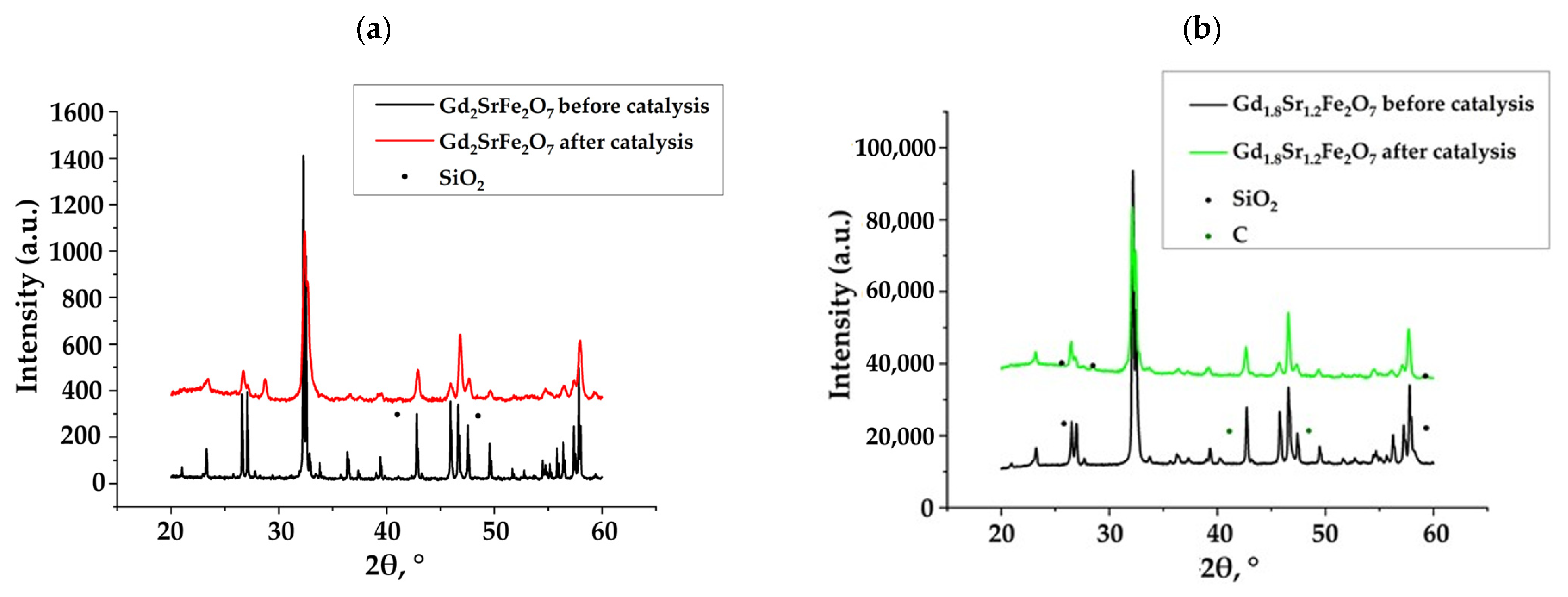
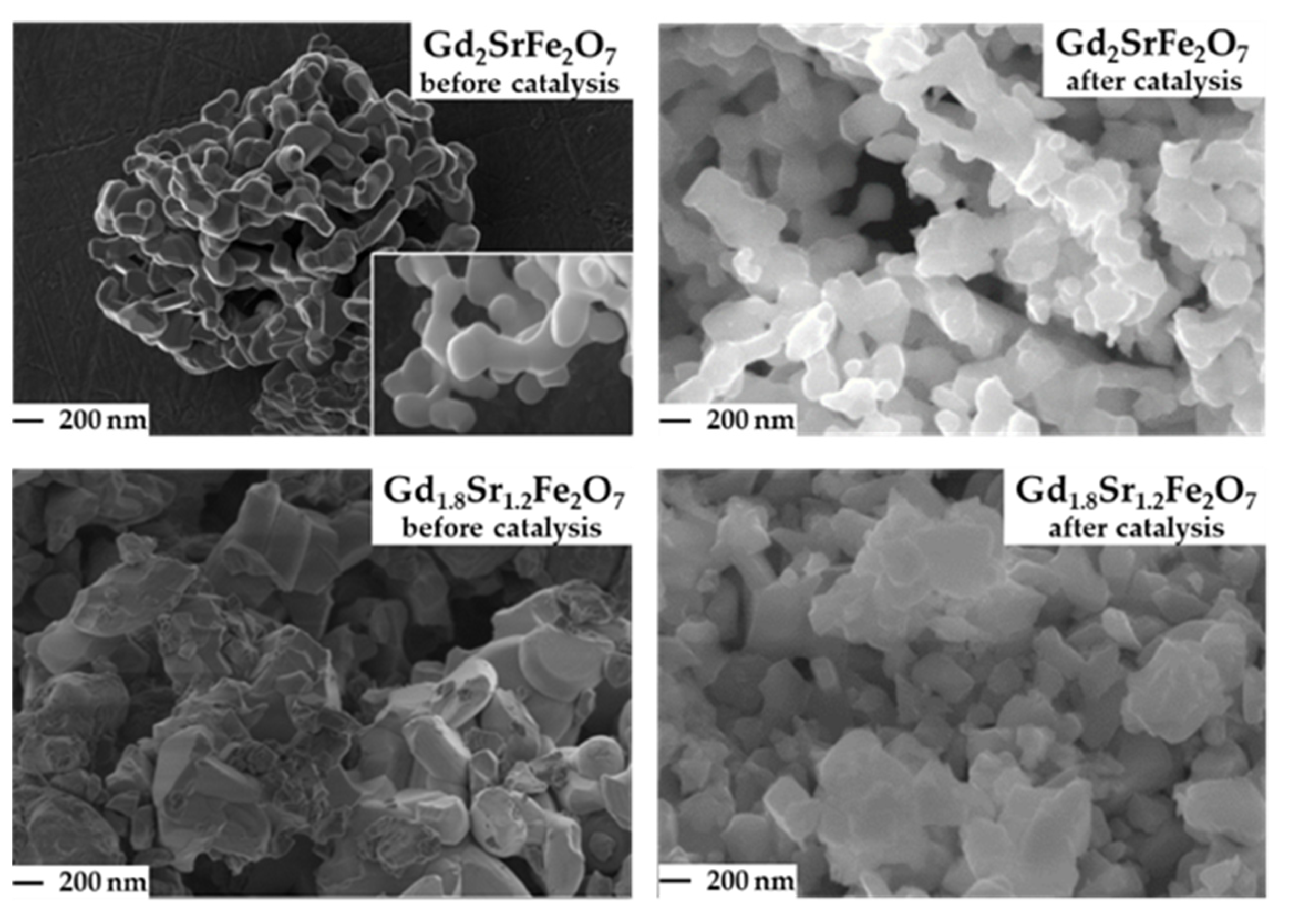
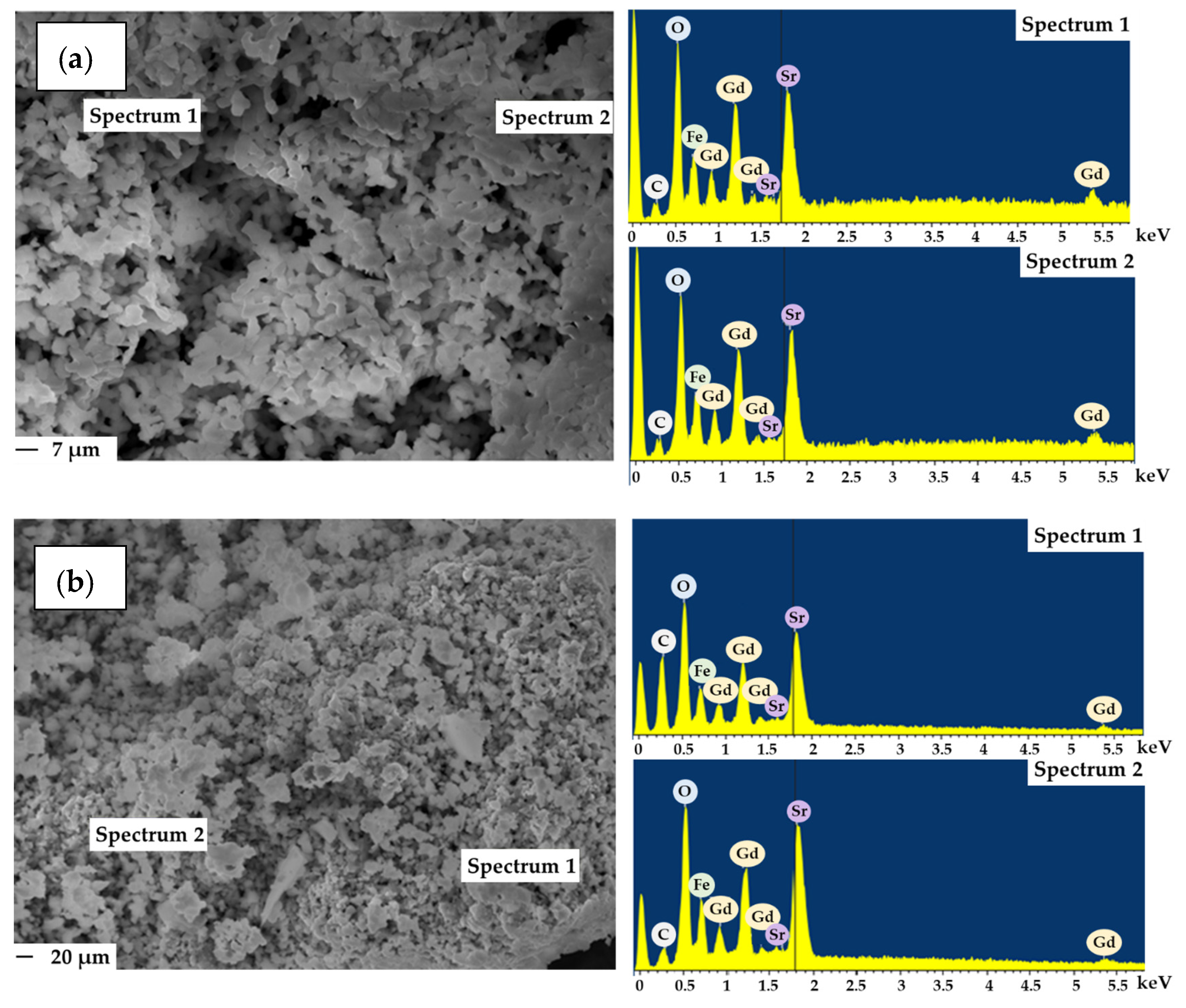


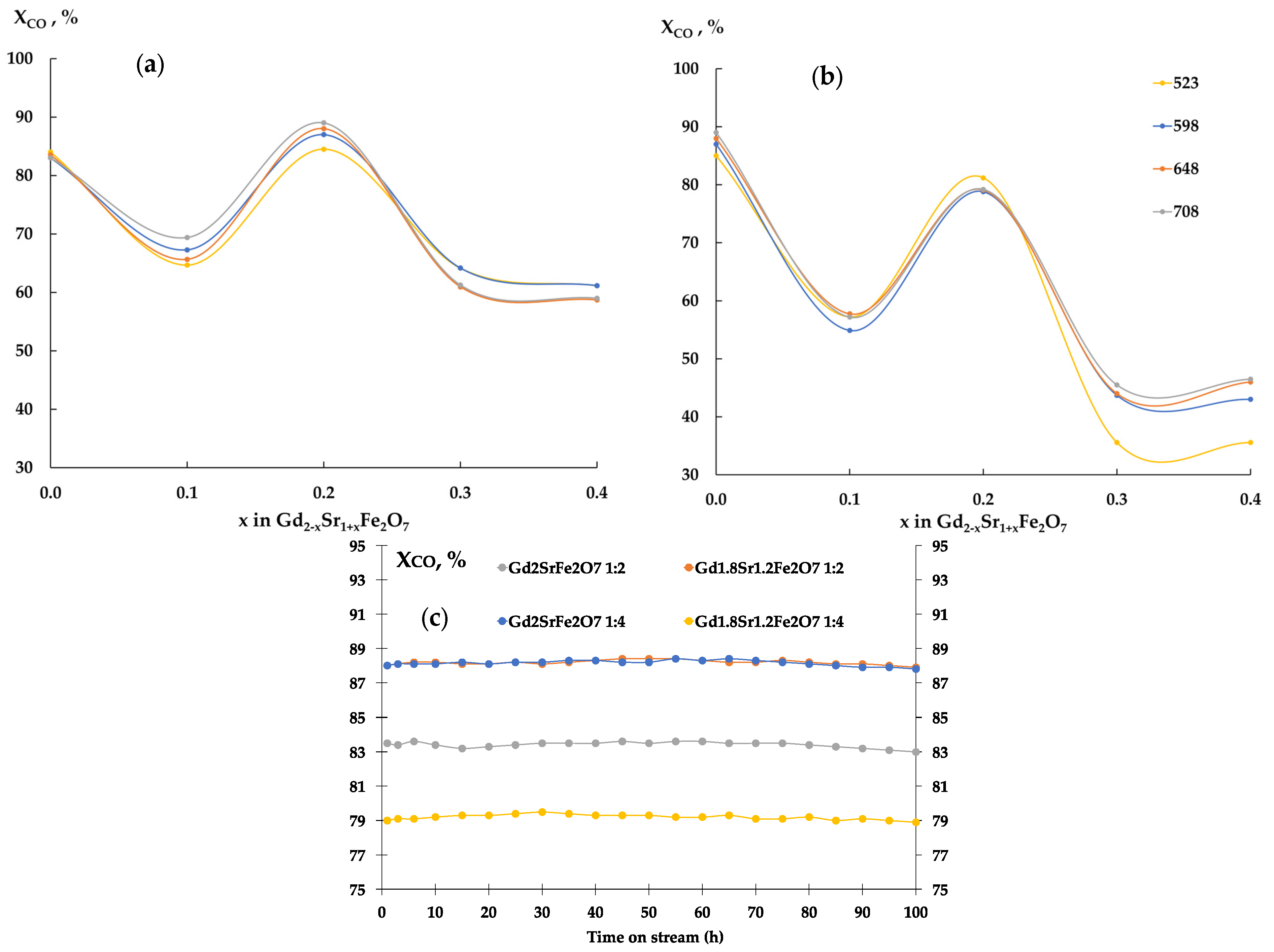
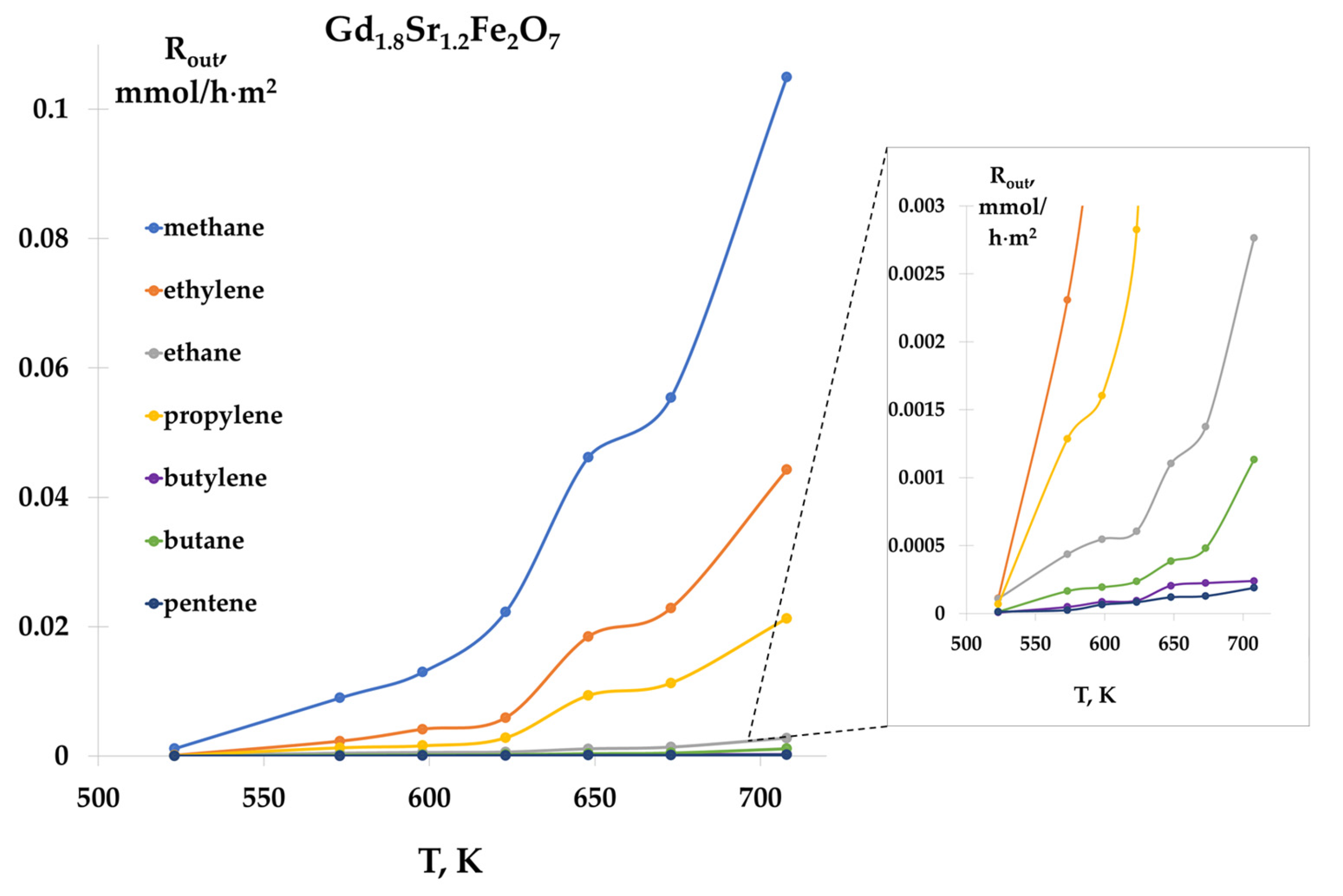
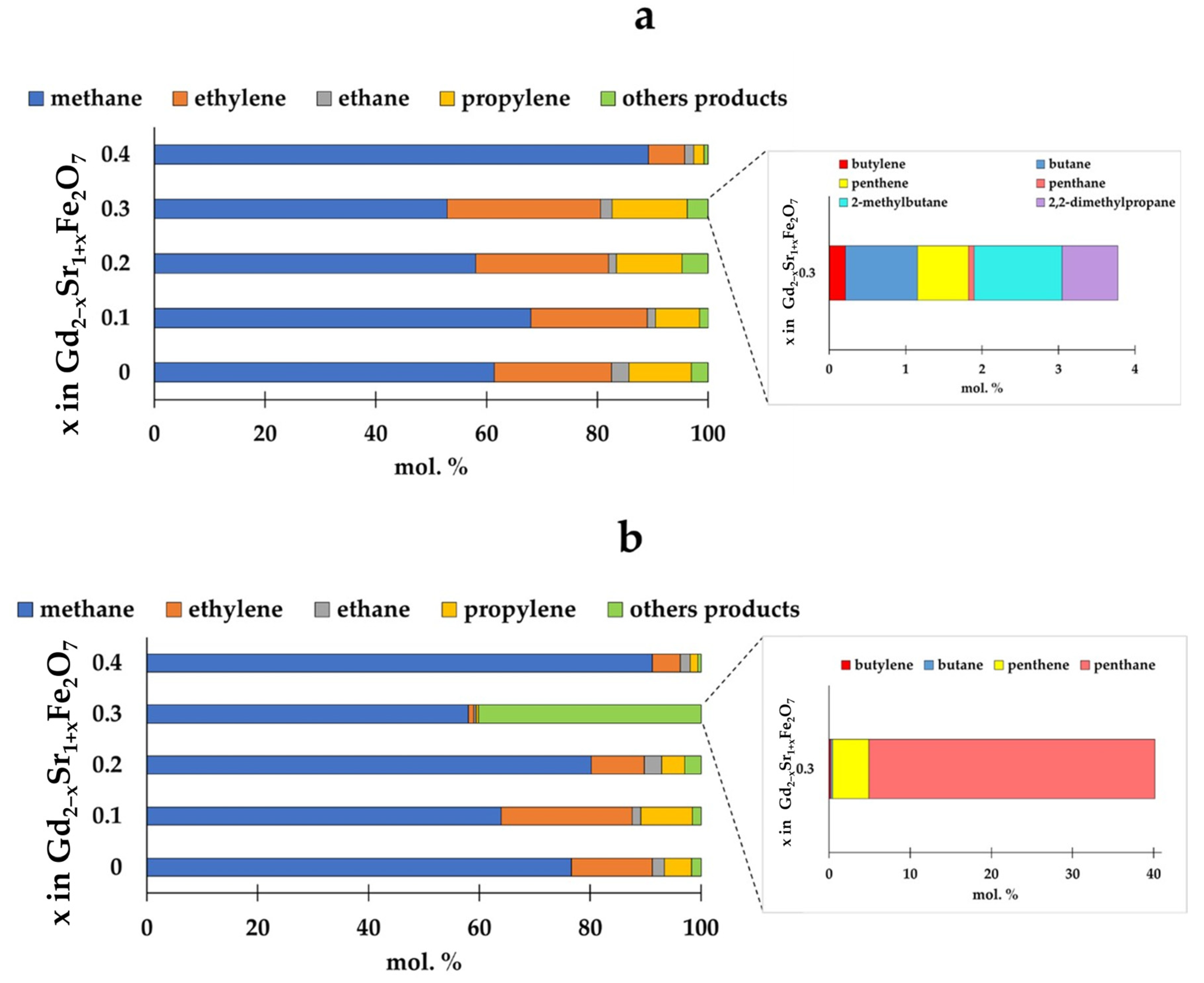


| Compound | Lattice Parameters (Å) | XRD Crystallite Size (nm) | Space Group | SBET (m2/g) |
|---|---|---|---|---|
| Gd2SrFe2O7 | a = b = 3.891 c = 19.736 | 49.3 | I4mmm [24] | 4.4 |
| Gd1.9Sr1.1Fe2O7 | a = b = 3.888 c = 19.784 | 45.3 | I4mmm [24] | 5.0 |
| Gd1.8Sr1.2Fe2O7 | a = b = 3.887 c = 19.783 | 48.0 | I4mmm [24] | 4.8 |
| Gd1.7Sr1.3Fe2O7 | a = b = 3.885 c = 19.790 | 43.2 | I4mmm [24] | 4.8 |
| Gd1.6Sr1.4Fe2O7 | a = b = 3.884 c = 19.829 | 30.3 | I4mmm [24] | 1.9 |
| Compound | Fe Ion | Chemical Shift (mm/s) | Quadrupole Splitting, (mm/s) | Field (T) | Content (%) |
|---|---|---|---|---|---|
| Before Catalysis | |||||
| Gd2SrFe2O7 | Fe4+ | 0.07 | - | - | 13 |
| Fe+3 | 0.36 | 0.41 | 45.40 | 27 | |
| Fe+3 | 0.36 | 0.37 | 43.53 | 23 | |
| Fe+3 | 0.36 | 0.36 | 40.31 | 37 | |
| Gd2SrFe2O7 | Fe+3 | 0.15 | 1.02 | - | 11 |
| Fe+3 | 0.35 | 0.40 | 46.44 | 70 | |
| Fe+3 | 0.41 | -0.0 | 49.90 | 19 | |
| Gd1.9Sr1.1Fe2O7 | Fe4+ | 0.002 | - | - | 15 |
| Fe+3 | 0.34 | 0.42 | 45.76 | 27 | |
| Fe+3 | 0.36 | 0.39 | 43.92 | 24 | |
| Fe+3 | 0.38 | 0.35 | 41.20 | 34 | |
| Gd1.8Sr1.2Fe2O7 | Fe4+ | 0.13 | - | - | 18 |
| Fe+3 | 0.34 | 0.43 | 45.15 | 24 | |
| Fe+3 | 0.36 | 0.40 | 42.98 | 38 | |
| Fe+3 | 0.48 | 0.48 | 38.16 | 20 | |
| Gd1.7Sr1.3Fe2O7 | Fe4+ | 0.19 | - | - | 27 |
| Fe+3 | 0.37 | 0.43 | 43.73 | 39 | |
| Fe+3 | 0.35 | 0.31 | 39.92 | 22 | |
| Fe+3 | 0.50 | 0.42 | 34.38 | 12 | |
| Gd1.6Sr1.4Fe2O7 | Fe4+ | 0.18 | - | - | 25 |
| Fe+3 | 0.36 | 0.39 | 41.87 | 63 | |
| Fe+3 | 0.32 | 0.38 | 37.30 | 12 | |
| after catalysis | |||||
| Gd2SrFe2O7 | Fe+3 | 0.15 | 1.02 | - | 11 |
| Fe+3 | 0.35 | 0.40 | 46.44 | 70 | |
| Fe+3 | 0.41 | −0.0 | 49.90 | 19 | |
| Gd1.8Sr1.2Fe2O7 | Fe+3 | 0.50 | 0.15 | - | 10 |
| Fe+3 | 0.37 | 0.43 | 46.50 | 80 | |
| Fe+3 | −0.02 | −0.06 | 32.75 | 10 | |
| Compound | W1, μmol/(g·min) | W2, μmol/(g·min) | Nmax, μmol/g | |||
|---|---|---|---|---|---|---|
| Before Catalysis | After Catalysis | Before Catalysis | After Catalysis | Before Catalysis | After Catalysis | |
| Gd2SrFe2O7 | 0.513 | 0.477 | 0.071 | 0.627 | 30.3 | 45.2 |
| Gd1.9Sr1.1Fe2O7 | - | 0.448 | - | 0.339 | 27.4 | 33.9 |
| Gd1.8Sr1.2Fe2O7 | 0.378 | 0.545 | 0.024 | 0.331 | 17.1 | 48.1 |
| Gd1.7Sr1.3Fe2O7 | 0.397 | 0.673 | 0.054 | 0.378 | 28.3 | 36.7 |
| Gd1.6Sr1.4Fe2O7 | - | 0.310 | - | 0.036 | 24.4 | 35.0 |
Disclaimer/Publisher’s Note: The statements, opinions and data contained in all publications are solely those of the individual author(s) and contributor(s) and not of MDPI and/or the editor(s). MDPI and/or the editor(s) disclaim responsibility for any injury to people or property resulting from any ideas, methods, instructions or products referred to in the content. |
© 2023 by the authors. Licensee MDPI, Basel, Switzerland. This article is an open access article distributed under the terms and conditions of the Creative Commons Attribution (CC BY) license (https://creativecommons.org/licenses/by/4.0/).
Share and Cite
Sheshko, T.F.; Borodina, E.M.; Yafarova, L.V.; Markova, E.B.; Kryuchkova, T.A.; Cherednichenko, A.G.; Zvereva, I.A.; Terent’ev, A.O. Insights into the Reactivity of Gd2−xSrxFe2O7 (x = 0 ÷ 0.4) in CO Radical Hydrogenation. Catalysts 2023, 13, 1256. https://doi.org/10.3390/catal13091256
Sheshko TF, Borodina EM, Yafarova LV, Markova EB, Kryuchkova TA, Cherednichenko AG, Zvereva IA, Terent’ev AO. Insights into the Reactivity of Gd2−xSrxFe2O7 (x = 0 ÷ 0.4) in CO Radical Hydrogenation. Catalysts. 2023; 13(9):1256. https://doi.org/10.3390/catal13091256
Chicago/Turabian StyleSheshko, Tatiana F., Elizaveta M. Borodina, Liliya V. Yafarova, Ekaterina B. Markova, Tatiana A. Kryuchkova, Alexander G. Cherednichenko, Irina A. Zvereva, and Alexander O. Terent’ev. 2023. "Insights into the Reactivity of Gd2−xSrxFe2O7 (x = 0 ÷ 0.4) in CO Radical Hydrogenation" Catalysts 13, no. 9: 1256. https://doi.org/10.3390/catal13091256




